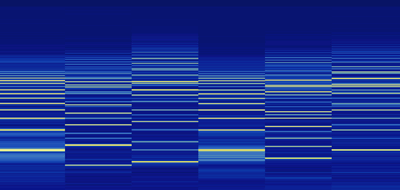Time pixelation on sound
For this series of examples I chose to experiment with what I call time pixelation of sound. It consists in taking the image of a sound, pixelating it horizontally only, then turning it back into a sound.
It is simply achieved by doing the following :
-Open a sound in Photosounder
-Save the image
-Open the image in your favourite image editor (Photoshop, GIMP, MS Paint, etc..)
-Squeeze your image horizontally to a given width, make sure to choose the Nearest Neighbour method
-Stretch your image horizontally back to its original width, make sure to use the Nearest Neighbour method again so the result looks "blocky"
-Open the modified image in Photosounder
(All of the above can be reproduced using the Photosounder Demo)
This has the effect of taking a short bit of the initial sound at regular intervals, and stretching it in time. For varying results, experiment with the width you squeeze the image to, but also with the horizontal offset in the original image. Moving the image a few pixels to the left or right results in the resizing method to pick different columns of pixels.
A few examples
This is 2001: A Space Odyssey's HAL 9000 speaking with only 10 pixels a second.

Once pixelated to about 3 pixels a second and looped back and forth, speech can turn out to adopt some almost catchy musical qualities.
A strings sample (above) reduced to 16 pixels (below) :

The arpeggio at the beginning of The Animals' House of the Rising Sun, first reduced to 6 pixels, then 12 pixels, 24, 48, 96 and finally the original full 1200 pixel image. It is interesting to note how this process can "de-arpeggiate" an arpeggio by selecting only notes at regular intervals.
It is simply achieved by doing the following :
-Open a sound in Photosounder
-Save the image
-Open the image in your favourite image editor (Photoshop, GIMP, MS Paint, etc..)
-Squeeze your image horizontally to a given width, make sure to choose the Nearest Neighbour method
-Stretch your image horizontally back to its original width, make sure to use the Nearest Neighbour method again so the result looks "blocky"
-Open the modified image in Photosounder
(All of the above can be reproduced using the Photosounder Demo)
This has the effect of taking a short bit of the initial sound at regular intervals, and stretching it in time. For varying results, experiment with the width you squeeze the image to, but also with the horizontal offset in the original image. Moving the image a few pixels to the left or right results in the resizing method to pick different columns of pixels.
A few examples
This is 2001: A Space Odyssey's HAL 9000 speaking with only 10 pixels a second.

Once pixelated to about 3 pixels a second and looped back and forth, speech can turn out to adopt some almost catchy musical qualities.
A strings sample (above) reduced to 16 pixels (below) :

The arpeggio at the beginning of The Animals' House of the Rising Sun, first reduced to 6 pixels, then 12 pixels, 24, 48, 96 and finally the original full 1200 pixel image. It is interesting to note how this process can "de-arpeggiate" an arpeggio by selecting only notes at regular intervals.
Labels: effect, experiments, time


0 Comments:
Post a Comment
Links to this post:
Create a Link
<< Home